Endometriosis: Recognizing the Symptoms

Endometriosis: a condition resulting from the appearance of endometrial tissue outside the uterus and causing pelvic pain, especially associated with menstruation.
That is the official definition. But, ask a sufferer of Endometriosis what the definition is, and the answer is usually, “living in a private prison.” In the past few years, public figures like Padma Lakshmi and Lena Dunham have brought the disease into focus by publicly discussing what is a very private battle that many women suffer from.
Most women will experience mild Endometriosis symptoms with few experiencing moderate to severe symptoms. It’s also important to know that the severity of your symptoms don’t necessarily reflect the the severity of your condition. (For example, you could show mild symptoms in an advanced stage of the disease and vice versa.)
Symptoms of Endometriosis:
There are many symptoms of Endometriosis, pelvic pain being the most common. But many women also experience the following:
- Bleeding between periods
- Heavy menstrual bleeding
- Pain following sexual intercourse
- Cramps 1-2 weeks around menstruation
- Uncomfortable bowel movements
- Infertility
Stages of Endo:
- Stage I: Minimal – There are small lesions or wounds and shallow endometrial implants on your ovary. You may also have inflammation around your pelvic cavity.
- Stage 2: Mild – Light lesions and shallow implants on an ovary and the pelvic lining.
- Stage 3: Moderate – Deep implants on your ovary and pelvic lining. There may also be more lesions.
- Stage 4: Severe – Deep implants on your pelvic lining and ovaries. There may also be lesions on your fallopian tubes and bowels.
Alleviating Pain:
For many women, if the symptoms of Endometriosis are left untreated, it can cause major disrupt in their life. Though Endometriosis has no cure, the symptoms can be managed. Starting out with general ibuprofen is usually the first step, but may not work in all cases.
- Hormone Therapy – Supplements can sometimes stop the progression of the disease by regulating changes in hormones that promote uterine tissue growth.
- Hormonal Birth Control – By decreasing monthly growth of endometrial tissue, you can reduce or eliminate pain in less-severe cases.
- Gonadotropin-releasing hormone (GRNH) – GnRH agonists and antagonists block the production of estrogen, creating an artificial menopause. Taking small doses of estrogen and progesterone can help alleviate those symptoms.
Surgical Solutions:
Laparoscopy is a minimally invasive surgery used to both diagnose and remove endometrial tissue. The goal of this conservative surgery is to remove endometrial growth without damaging your reproductive organs. Hysterectomy is only used as a last resort if your condition doesn’t improve with treatments. Obviously, you won’t be able to get pregnant following a hysterectomy, so before making the final decision, make sure to get a second opinion.
If you’ve been diagnosed with Endo, you don’t have to suffer alone. There are many online resources and support groups that you can access from your own home. Feel free to contact a physician at Miami OBGYN for a consultation and advice.
